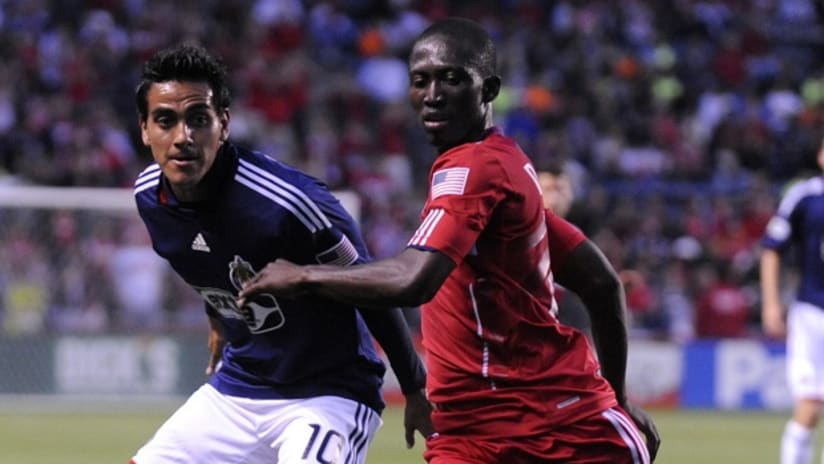The Carlos de los Cobos reign started with a whimper.
Chicago’s new boss surely hoped for better than two losses and a tie to begin his days in Bridgeview. But he kept tinkering with personnel and formations, tuning the instruments while listening hard for the perfect pitch.
Three games back, he may just have nailed it; the Fire are unbeaten since with a draw and two wins, including three important points on the road. What, exactly, was the light bulb that switched on for de los Cobos?
A five-man midfield. And there’s a lot of that going around these days in MLS.
The 4-4-2 may retain its long-held sovereignty as the base system, the “starting point” for most clubs in their initial strategic planning. But at least half the MLS sides have employed a five-man midfield at some point this year, for one reason or another.
(This should always be said before discussing formations: There’s a lot of splitting hairs here. The difference between a 4-5-1 and a 4-3-3 for instance, in some set-ups, may be as little as 10 to 15 yards of initial starting position on defense for the wide players. So, keep that in mind.)
Why the lean toward five in the midfield? It’s generally about personnel, about finding a system that squeezes the most quality from the roster, one that gets the best players on the field and into comfortable roles. The Fire have two strikers, Brian McBride and Collins John, who essentially play the same way. So it doesn’t make much sense to partner them in the lineup.
Meanwhile, no one had quite figured out how to get the best from forwardPatrick Nyarko’s pace and audacity. And it was increasingly difficult to getJustin Mapp on the field as young slasher Marco Pappa had clearly lapped the American midfielder.
Voila! Now Nyarko is a wide attacker on the right, Mapp is patrolling left and Pappa is set up behind McBride, ahead of two holding midfielders in a 4-5-1 or a 4-2-3-1 (take your pick). Nyarko is the ideal candidate in a lot of ways to attack from the wings; he really doesn’t lose much speed, if any at all, with the ball at his feet.
The two holding midfielders aren’t necessarily consigned entirely to screening duty. Baggio Husidic has been stationed lately as one of the Fire’s two defensive midfielders—and he has two goals in the team’s last two matches.
Chicago’s opponent on Saturday, Chivas USA, have used two different versions of the five-man midfield. Earlier this year, Martin Vasquez’s team lined up in a conservative 4-5-1, with a lone striker and lots of defending in the midfield. Lately, the Goats have tested a less defensive 3-5-2.
Occasionally, teams in a 4-4-2 will add a midfielder mid-stream to match the man-advantage in the middle. Twice this year, for instance, that has happened against Dallas.
FC Dallas line up in a 4-1-4-1, with Daniel Hernandez sitting deep behindDax McCarty and David Ferreira in the middle. It’s essentially a five-man midfield. The bottom line is a fairly well-linked three-man central triangle that has the ability to dominate matches, even on the road. It happened earlier this year at New York and again over the weekend at New England. In both cases, FCD ran roughshod over the home team for a half. (The finishing, in both cases, was another issue—but let’s stay on topic here.)
In both cases, managers for the home side added a midfielder at the half to help stanch the one-way traffic in midfield. Red Bull’s Hans Backe and New England’s Steve Nicol did it the same way, subtracting a forward in favor of a wide midfielder and sliding an extra man into the middle. Nicol said he had no choice but to negate the 3-vs.-2 advantage in the middle of the field.
“We were getting totally out-played through the middle of the park,” he said. “They were just rolling balls in between us through the middle of the field. It was only a matter of time before they scored if we continued to let them do that.”
Kansas City play a dynamic 4-3-3 this year. Real Salt Lake toyed with the three-forward alignment last year. And Seattle lined up that way over the weekend against Columbus, as manager Sigi Schmid probed for ways to punch up scoring production—which is curiously light considering the trio of peppy, high-profile attackers on site in Freddie Ljungberg, Fredy Montero andSteve Zakuani.
There’s also the example of where a 4-3-3 looks quite like a 4-5-1. The three-man central triangle is essentially the same. In the middle, it looks just like the 4-5-1 (the triangle could “point” either way.) The difference more or less is where the wide guys start defending. Do they pressure the fullbacks as Zakuani and Brad Evans did Saturday against Columbus? Or do they retreat further back, connecting with the men in the middle to form a most substantial block of five?
There’s also a “tweener” state in which some teams dwell. Columbus deploy an alleged 4-4-2. One of the “forwards,” former league MVP Guillermo Barros Schelotto roams, well, pretty much wherever he wants. He’s somewhere behind a striker and ahead of central midfielders Brian Carroll and Adam Moffat, using his veteran wile to find the spaces available on the day. A lot of times, that’s back in the midfield. So, is that a 4-5-1?
Who cares? Again, the difference is academic. And it gets results: The Crew are still undefeated.


